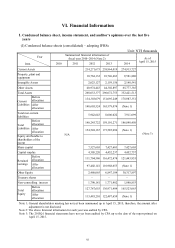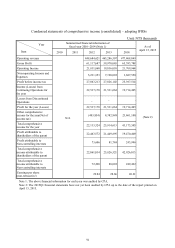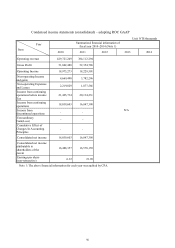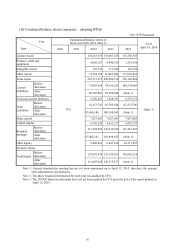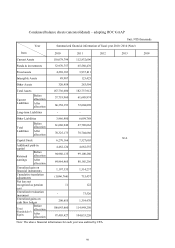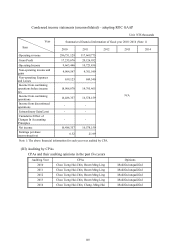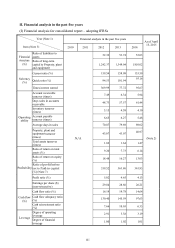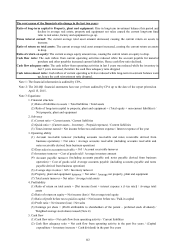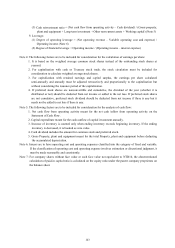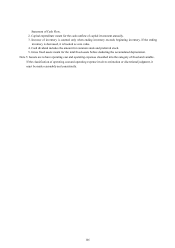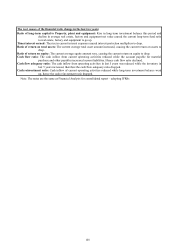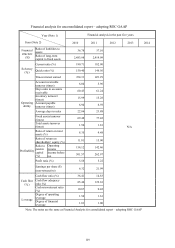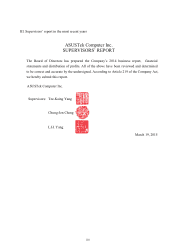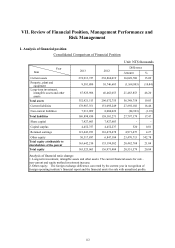Asus 2014 Annual Report Download - page 106
Download and view the complete annual report
Please find page 106 of the 2014 Asus annual report below. You can navigate through the pages in the report by either clicking on the pages listed below, or by using the keyword search tool below to find specific information within the annual report.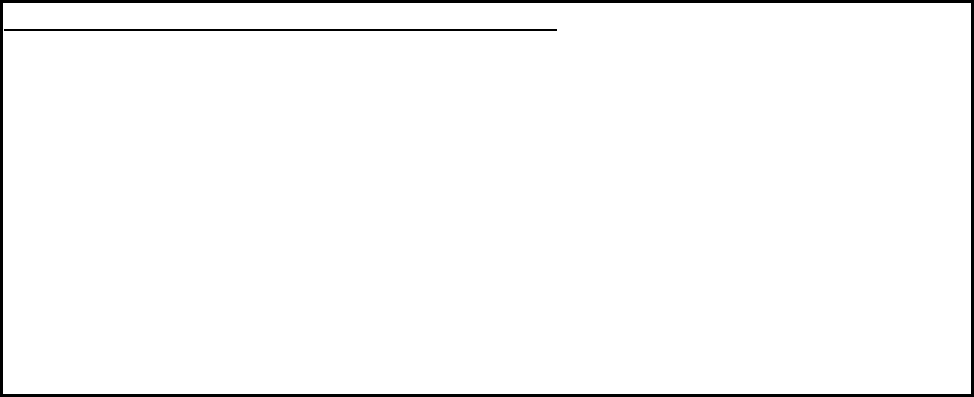
102
The root causes of the financial ratio change in the last two years:
Ratio of long-term capital to Property, plant and equipment: Rise in long-term investment balance this period and
decline in average real estate, property and equipment net value caused the current long-term fund
ratio to real estate, factory and equipment to go up.
Times interest earned: The current average total asset amount decreased, causing the current return on assets to
increase.
Ratio of return on total assets: The current average total asset amount increased, causing the current return on assets
to drop.
Ratio of return on equity: The current average equity amount rose, causing the current return on equity to drop.
Cash flow ratio: The cash inflow from current operating activities reduced while the account payable for material
purchase and other payables increased current liabilities. Hence cash flow ratio declined.
Cash flow adequacy ratio: The cash inflow from operating activities in last 5 years was reduced while the inventory in
last 5 years increased, therefore the cash flow adequacy ratio dropped.
Cash reinvestment ratio: Cash inflow of current operating activities reduced while long-term investment balance went
up, hence the cash reinvestment ratio dropped.
Note 1: The financial information is audited by CPA.
Note 2: The 2014Q1 financial statements have not yet been audited by CPA up to the date of the report printed on
April 15, 2015.
Note 3: Equations:
1. Financial structure
(1) Ratio of liabilities to assets = Total liabilities / Total assets
(2) Ratio of long-term capital to property, plant and equipment = (Total equity + non-current liabilities) /
Net property, plant and equipment
2. Solvency
(1) Current ratio = Current assets / Current liabilities
(2) Quick ratio = (Current assets – Inventory – Prepaid expenses) / Current liabilities
(3) Times interest earned = Net income before tax and interest expense / Interest expense of the year
3. Operating ability
(1) Account receivable turnover (including accounts receivable and notes receivable derived from
business operation) = Net sales / Average accounts receivable (including accounts receivable and
notes receivable derived from business operation)
(2) Days sales in accounts receivable = 365 / Account receivable turnover
(3) Inventory turnover = Cost of goods sold / Average inventory amount
(4) Account payable turnover (including accounts payable and notes payable derived from business
operation) = Cost of goods sold/ Average accounts payable (including accounts payable and notes
payable derived from business operation)
(5) Average days in sales = 365 / Inventory turnover
(6) Property, plant and equipment turnover = Net sales / Average net property, plant and equipment
(7) Total assets turnover = Net sales / Average total assets
4. Profitability
(1) Ratio of return on total assets = [Net income (loss) + interest expense x (1-tax rate)] / Average total
assets
(2) Ratio of return on equity = Net income (loss) / Net average total equity
(3) Ratio of profit before tax to paid-in capital = Net income before tax / Paid-in capital
(4) Profit ratio = Net income (loss) / Net sales
(5) Earnings per share = (Profit attributable to shareholders of the parent – preferred stock dividend) /
Weighted average stock shares issued (Note 4)
5. Cash flow
(1) Cash flow ratio = Net cash flow from operating activity / Current liabilities
(2) Cash flow adequacy ratio = Net cash flow from operating activity in the past five years / (Capital
expenditure + Inventory increase + Cash dividend) in the past five years



